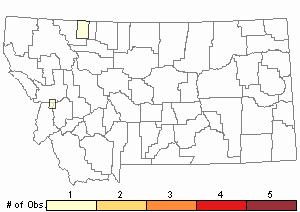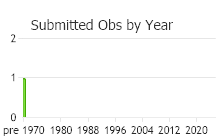View in other NatureServe Network Field Guides
NatureServe
Montana
Utah
Wyoming
Idaho
Wisconsin
British Columbia
South Carolina
Yukon
California
New York
A Ptychostomum Moss - Ptychostomum pallens
Other Names:
Bryum pallens
General Description
Plants: Acrocarpous. Growing in loose to crowded, large patches (FNA 2014) or clumps of erect shoots, sometimes mingling with other moss species (Lawton 1971), light pink to red, seldom a greyish-green. Stems 1-6 cm tall (FNA 2014), somewhat forked (Crum & Anderson et al. 1981), the fertile stems with leaves dense at the top (comose) (FNA 2014); rhizoids few to moderate in number (Crum & Anderson et al 1981).
Leaves: Somewhat laxly spaced on the stem below, more densely above (Crum & Anderson et al. 1981), twisted and curved to contracted when dry, spreading somewhat when moist, 1-4 mm in length (FNA 2014), 0.8 mm in width (Lawton 1971), egg-shaped to widely-lanceolate with ovate tendencies, plane or faintly cupped, steadily becoming larger with increased stem height, the distal part of the leaf tapered to an acumen; margins rolled back and down below, flat above, with a strong border (FNA 2014), smooth or seldom very finely toothed at the leaf tip (Lawton 1971); base green or pink, extending narrowly and slightly to considerably down the stem (FNA 2014); costa brown to reddish (Crum & Anderson et al. 1981), reaching the leaf tip or slightly beyond, forming a robust short awn (FNA 2014).
Leaf Cells: Border of 2-3 cell rows, parts of the proximal border 2-layered; lower laminal cells short and oblong, 2-4:1; medial and upper cells fine-walled, diamond-shaped to 6-sided, lacking pores, 2-3:1 (FNA 2014), the marginal cells longer and thinner than the medial cells (Lawton 1971).
Phenology
Fruit ripens in summer (FNA 2014).
Diagnostic Characteristics
The light pink color is not found in every plant.
Bryum pallens is closely related to Bryum uliginosum, but B. pallens is dioicous rather than autoicous (FNA 2014).
Range Comments
AK to NL, NS and ME, also NY, MI, MN, and from MT to NM west to the coastal states (FNA 2014). Known in Montana from Carbon, Flathead, Gallatin, Glacier, Missoula, and Sanders Counties (Elliott 2016).
Observations in Montana Natural Heritage Program Database
Number of Observations: 2
(Click on the following maps and charts to see full sized version)
Map Help and Descriptions
Relative Density

Recency


 (Observations spanning multiple months or years are excluded from time charts)
(Observations spanning multiple months or years are excluded from time charts)
Habitat
Boreal habitats; moist soil (Elliott 2016) to wet soil on stream banks and wetlands; calcareous. Elevation: 0-9840 feet (FNA 2014).
Reproductive Characteristics
Dioicous. Seta 2-6 mm, robust, russet. Capsule ca 4-5 mm in length, long and pear-shaped to club-shaped, a little bowed (FNA 2014), level to drooping, changing from yellow to brown with age; neck gradually narrowing, and similar in length to the rest of the capsule, contracted when dry (Lawton 1971); peristome typically fully formed; exostome dentitions yellow below, transparent above (FNA 2014), minutely papillose (Lawton 1971), without pores near the lower mid-line; endostome sections with egg-shaped openings (FNA 2014), minutely papillose (Lawton 1971); cilia knobby to transversely ridged (FNA 2014).
Specialized vegetative reproduction occurring in the form of gemmae borne in the leaf axils, the gemmae russet to green with minute papillae (FNA 2014).
References
- Literature Cited AboveLegend:
 View Online Publication
View Online Publication Crum, H.A. and L.E. Anderson. 1981. Mosses of Eastern North America. 2 volumes. Columbia University Press, New York. 1328 pp.
Crum, H.A. and L.E. Anderson. 1981. Mosses of Eastern North America. 2 volumes. Columbia University Press, New York. 1328 pp. Elliott, J.C. and A.K. Pipp. 2018. A Checklist of Montana Mosses (1880-2018). Updated 3 January, 2020. Montana Natural Heritage Program, Helena, Montana. 73 pp.
Elliott, J.C. and A.K. Pipp. 2018. A Checklist of Montana Mosses (1880-2018). Updated 3 January, 2020. Montana Natural Heritage Program, Helena, Montana. 73 pp. Flora of North America Editorial Committee, eds. 2014. Flora of North America North of Mexico. Volume 28. Bryophytes: Mosses, Part 2. Oxford University Press, Inc., NY. xxi + 702 pp.
Flora of North America Editorial Committee, eds. 2014. Flora of North America North of Mexico. Volume 28. Bryophytes: Mosses, Part 2. Oxford University Press, Inc., NY. xxi + 702 pp. Lawton, E. 1971. Moss Flora of the Pacific Northwest. Hattori Botanical Laboratory. Japan: Yamabuki-cho, Shinjuku-ku, Tokyo. 362 pages plus appendices.
Lawton, E. 1971. Moss Flora of the Pacific Northwest. Hattori Botanical Laboratory. Japan: Yamabuki-cho, Shinjuku-ku, Tokyo. 362 pages plus appendices.
- Additional ReferencesLegend:
 View Online Publication
View Online Publication
Do you know of a citation we're missing? Elliot, J. C. 1993. Second checklist of Montana mosses. Unpublished report. U.S. Forest Service, Region 1. Missoula, MT. 45 pp.
Elliot, J. C. 1993. Second checklist of Montana mosses. Unpublished report. U.S. Forest Service, Region 1. Missoula, MT. 45 pp. Flowers, S. 1973. Mosses: Utah and the West. Brigham Young University, Provo, Utah. 567 p.
Flowers, S. 1973. Mosses: Utah and the West. Brigham Young University, Provo, Utah. 567 p. Lawton, E. 1971. Keys for the Identification of the Mosses on the Pacific Northwest. Reprinted from 'Moss Flora of the Pacific Northwest'. Published as Supplement No. 2 of the Journal of the Hattori Botanical Laboratory. Nichinan, Miyazaki, Japan. 66 pp.
Lawton, E. 1971. Keys for the Identification of the Mosses on the Pacific Northwest. Reprinted from 'Moss Flora of the Pacific Northwest'. Published as Supplement No. 2 of the Journal of the Hattori Botanical Laboratory. Nichinan, Miyazaki, Japan. 66 pp. Malcolm, B., N. Malcolm, J. Shevock, and D. Norris. 2009. California Mosses. Nelson, New Zealand: Micro-Optics Press. 430 pp.
Malcolm, B., N. Malcolm, J. Shevock, and D. Norris. 2009. California Mosses. Nelson, New Zealand: Micro-Optics Press. 430 pp. Smith, A.J.E. 1980. The Moss Flora of Britain and Ireland. Cambridge University Press, Cambridge. 705 pp.
Smith, A.J.E. 1980. The Moss Flora of Britain and Ireland. Cambridge University Press, Cambridge. 705 pp. Vitt, D. J. Marsh, and R. Bovey. 1988. Mosses, Lichens & Ferns of Northwest North America. Seattle, WA: University of Washington Press. 296 p.
Vitt, D. J. Marsh, and R. Bovey. 1988. Mosses, Lichens & Ferns of Northwest North America. Seattle, WA: University of Washington Press. 296 p.
- Web Search Engines for Articles on "A Ptychostomum Moss"





